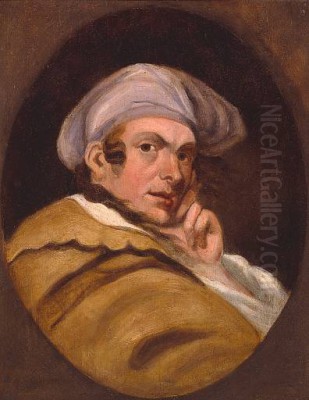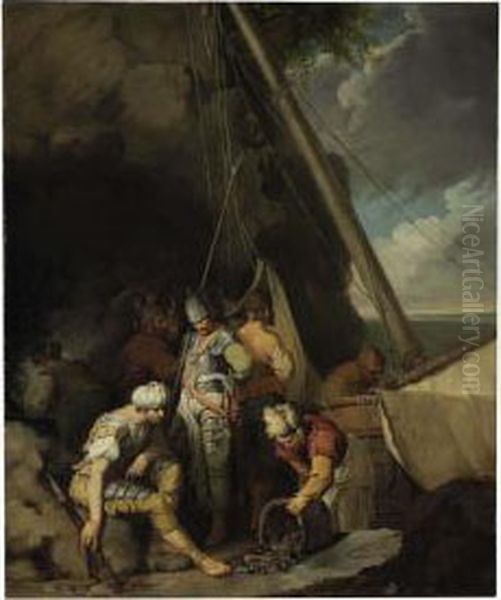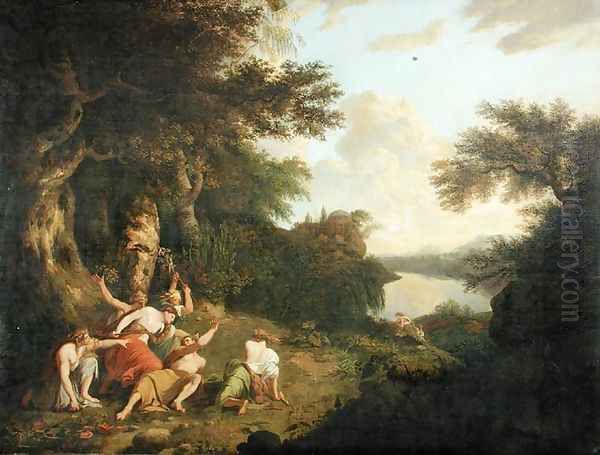
John Hamilton Mortimer stands as a fascinating, albeit tragically short-lived, figure in the landscape of 18th-century British art. Active during a period of significant transition, his work uniquely straddled the waning influence of Neoclassicism and the burgeoning spirit of Romanticism. Known for his dynamic compositions, dramatic subject matter, and exceptional skill as a draughtsman and etcher, Mortimer carved out a distinct niche for himself, often exploring themes of heroism, villainy, the sublime, and the literary, particularly the works of Shakespeare. His premature death at the age of 39 cut short a career brimming with potential, yet his extant works continue to command attention for their vigour and imaginative power.
Early Life and Artistic Inclinations
Born in 1740 (some sources suggest 1741) in the coastal town of Eastbourne, Sussex, John Hamilton Mortimer was the youngest son of Thomas Mortimer, a customs officer who also operated a mill. His early exposure to the dramatic coastal scenery of Sussex may have subtly influenced his later penchant for rugged landscapes and tempestuous themes. An uncle, who was reportedly an itinerant painter, is credited with first nurturing young Mortimer's artistic talents and encouraging him to pursue drawing. This familial support was crucial in setting him on a path towards a professional artistic career, a choice that was not always readily accepted or easily sustained in the 18th century.
Recognizing his burgeoning talent, Mortimer was sent to London to receive formal artistic training. This move to the bustling capital was a pivotal step, placing him at the heart of Britain's rapidly developing art world. London offered access to established masters, collections of art, and the competitive environment of burgeoning art societies, all essential for an aspiring artist's development.
Formal Training and Formative Influences

Around the age of 17 or 18, Mortimer entered the studio of Thomas Hudson, a leading portrait painter of the day and the former master of Sir Joshua Reynolds. Hudson's studio was a well-regarded training ground, known for its methodical approach to portraiture. However, Mortimer's temperament, which leaned towards more imaginative and dramatic subjects, did not entirely align with Hudson's conventional style. He reportedly found the routine of face-painting and drapery studies uninspiring and did not remain with Hudson for an extended period.
Following his departure from Hudson's studio, Mortimer sought out environments more conducive to his artistic inclinations. He is known to have studied at the Duke of Richmond's gallery in Whitehall, which housed a collection of casts from antique sculptures. This provided him with invaluable exposure to classical forms, which would inform the anatomical precision and heroic figuration in his later works. He also briefly associated with Robert Edge Pine, a painter known for his historical subjects and radical political views, which might have resonated with Mortimer's own independent spirit.
A significant influence on Mortimer's developing style was the work of the 17th-century Italian Baroque painter Salvator Rosa. Rosa's dramatic landscapes, populated with banditti, soldiers, and scenes of witchcraft, captivated the British imagination in the 18th century and were central to the aesthetic concept of the "Sublime." Mortimer deeply admired Rosa's untamed energy and romantic subject matter, and this influence is palpable in many of Mortimer's own depictions of brigands, wild landscapes, and scenes imbued with a sense of danger and awe.
The Emergence of a Distinctive Style: Neoclassicism Meets Romanticism
Mortimer's artistic style is often characterized as a bridge between Neoclassicism and Romanticism. From Neoclassicism, he drew a strong sense of line, anatomical accuracy, and an interest in historical and mythological subjects. His figures often possess a sculptural quality, reminiscent of classical statuary. However, he infused these classical forms with a dynamic energy, emotional intensity, and a penchant for the dramatic and sometimes grotesque that were hallmarks of the emerging Romantic sensibility.
His brushwork was typically bold, confident, and energetic, conveying a sense of immediacy and vigour. He was particularly adept at capturing movement and dramatic tension in his compositions. Unlike many of his contemporaries who favored polished finishes, Mortimer's work often retained a sense of raw power and unbridled creativity. He was not afraid to tackle subjects that were violent, unsettling, or macabre, setting him apart from the more genteel tastes that often prevailed. This willingness to explore the darker aspects of human experience and the wilder side of nature aligned him with other proto-Romantic figures like Henry Fuseli and, to some extent, William Blake.
Mastery in Etching: Shakespeare and Banditti

While accomplished as a painter, John Hamilton Mortimer achieved particular renown for his etchings. He possessed a remarkable facility with the etching needle, creating prints that were both technically proficient and artistically expressive. His etchings often displayed a freedom and spontaneity that mirrored his drawing style.
One of his most significant projects in this medium was a series of twelve etchings depicting characters from Shakespeare, published between 1775 and 1776. These included memorable figures such as Caliban, Bardolph, Shylock, and Richard II. Mortimer's interpretations were highly original, often emphasizing the more grotesque or psychologically complex aspects of the characters. For instance, his "Caliban" is a powerful portrayal of the savage yet pitiable creature from The Tempest. This series was widely acclaimed and helped to solidify his reputation as an imaginative interpreter of England's greatest playwright. His engagement with Shakespearean themes placed him in the company of other artists of the period who were also drawn to these subjects, such as George Romney and Henry Fuseli.
Another prominent theme in his etchings, as in his paintings, was that of "banditti" – Italian bandits or brigands. These figures, romanticized as symbols of freedom and defiance, were popular subjects in 18th-century art, largely due to the influence of Salvator Rosa. Mortimer produced numerous etchings of banditti in dramatic landscapes, often engaged in fierce encounters or moments of quiet menace. These works, such as "Banditti Fishing" or "Banditti in a Mountainous Landscape," captured the public's fascination with the exotic and the untamed.
In 1778, he produced a notable set, "Fifteen Etchings Dedicated to Sir Joshua Reynolds." This series, showcasing a variety of subjects including monstrous figures and scenes inspired by Rosa, further demonstrated his mastery of the medium and his unique artistic vision. Reynolds, as the President of the Royal Academy, was the leading figure in the British art establishment, and dedicating this series to him was a significant gesture.
Key Thematic Concerns in Paintings and Drawings
Mortimer's thematic range was broad, encompassing historical, religious, literary, and genre subjects. His history paintings often depicted scenes of heroism, conflict, and moral drama. A notable example is "St. Paul Preaching to the Ancient Britons," a large and ambitious work commissioned for the church in High Wycombe, Buckinghamshire, and later exhibited at the Society of Artists in 1777. This painting, with its dynamic composition and expressive figures, showcased his ability to handle complex multi-figure narratives on a grand scale. He also undertook decorative schemes, such as a "Brazen Serpent" for Salisbury Cathedral and wall paintings for Brasenose College, Oxford, further highlighting his versatility.
His drawings were highly prized for their fluency and power. He was a prolific draughtsman, and his sketches often reveal the initial spark of his imaginative compositions. Many of these drawings, executed in pen and ink or wash, possess a remarkable vitality and demonstrate his skill in capturing anatomical detail and expressive gesture. Subjects ranged from preparatory studies for larger paintings to independent works depicting mythological scenes, banditti, or characters from literature.
The influence of classical antiquity remained a constant, but it was often filtered through his romantic temperament. He was less interested in the serene idealism of Neoclassicism championed by figures like Anton Raphael Mengs or Gavin Hamilton, and more drawn to the dramatic potential of classical narratives, often focusing on moments of conflict or intense emotion.
Contemporaries and the Artistic Milieu of 18th-Century London
John Hamilton Mortimer operated within a vibrant and competitive artistic milieu in London. The latter half of the 18th century saw the establishment of key institutions like the Society of Artists (founded in 1761) and the Royal Academy of Arts (founded in 1768), which provided platforms for artists to exhibit their work and gain patronage.
Mortimer was a prominent member of the Society of Artists, serving as its Vice-President in 1773 and President in 1774. He exhibited regularly at the Society from 1762 onwards, showcasing a diverse range of works including portraits, historical pieces, and his popular banditti scenes. His success at the Society, where he won several premiums (awards) for historical painting, demonstrated his early recognition.
His contemporaries included some of the most celebrated names in British art. Sir Joshua Reynolds, the dominant figure of the era, championed the "Grand Manner" and history painting, though his primary practice was portraiture. Thomas Gainsborough, Reynolds's great rival, was renowned for his elegant portraits and idyllic landscapes. While Mortimer's style differed significantly from both, he shared their ambition to elevate the status of British art.
Other artists whose work bore some thematic or stylistic affinities with Mortimer's included Henry Fuseli, a Swiss-born artist whose paintings explored the realms of the supernatural, the dreamlike, and the terrifying, often drawing on literary sources like Shakespeare and Milton. Joseph Wright of Derby was another contemporary known for his dramatic use of chiaroscuro and his depictions of scientific experiments and industrial scenes, as well as romantic landscapes. James Barry, an Irish artist, was a fervent advocate for monumental history painting, often tackling ambitious and allegorical subjects.
Mortimer also had connections with artists like Philip James de Loutherbourg, who was known for his dramatic landscapes, seascapes, and battle scenes, and later for his innovative theatrical designs. The engraver William Woollett, who reproduced works by many leading artists, also engraved some of Mortimer's paintings, helping to disseminate his images to a wider audience. Even the visionary poet and artist William Blake, though younger, was emerging during Mortimer's later years, and shared an interest in imaginative and literary themes, albeit expressed in a highly personal and mystical style. Angelica Kauffman, another prominent female artist of the Royal Academy, specialized in historical and allegorical subjects, often with a more graceful and sentimental touch than Mortimer's robust style.
The Enigmatic Relationship with William Hogarth
While William Hogarth (1697-1764) belonged to an earlier generation, his influence on British art was profound and long-lasting. Hogarth was a master of narrative painting and satirical prints, creating "modern moral subjects" that commented on contemporary life and manners. There isn't extensive documentation detailing a direct mentorship or close personal tie between Hogarth and the younger Mortimer, especially given Hogarth's death when Mortimer was in his early twenties and just beginning to establish himself.
However, it's plausible that Mortimer, like many artists of his generation, would have been aware of and influenced by Hogarth's powerful visual storytelling and his robust, characterful figures. Hogarth's emphasis on direct observation and his ability to capture vivid human expression may have resonated with Mortimer's own interest in dramatic characterization. Furthermore, Hogarth's success as an independent artist and printmaker, who often challenged the established artistic conventions of his time, might have provided an inspiring model for an artist like Mortimer, who also possessed a somewhat rebellious and individualistic streak. Some sources suggest a friendly acquaintance, and Mortimer's involvement in the artistic societies of London would have placed him within circles where Hogarth's legacy was still very much alive. Mortimer's own satirical or character-driven etchings, like "Bardolph," certainly show an affinity for the kind of vivid character study that Hogarth excelled in.
The Society of Artists and the Royal Academy
Mortimer's career was significantly intertwined with the leading art institutions of his day. He was a loyal and active member of the Society of Artists of Great Britain, which was the primary exhibiting body for artists in London before the Royal Academy gained pre-eminence. His rise through the ranks of the Society, culminating in his presidency, indicates the respect he commanded among his peers. He exhibited a wide array of works there, from ambitious historical pieces like "King John Delivering Magna Charta to the Barons" to portraits and his ever-popular banditti scenes.
In 1778, relatively late in his short career, Mortimer was elected an Associate of the Royal Academy (ARA). This was a significant recognition from the most prestigious art institution in Britain, headed by Sir Joshua Reynolds. His election signaled his acceptance into the highest echelons of the London art world. His diploma work for the Royal Academy was "Hercules Slaying the Hydra." Had he lived longer, he would almost certainly have become a full Royal Academician (RA).
Later Years, Darker Themes, and Anecdotes
In his later years, Mortimer's art reportedly took a turn towards even darker and more fantastical themes. There are accounts of him exploring subjects like witchcraft, monsters, and scenes of heightened violence. This shift might reflect a deepening of his Romantic inclinations, a fascination with the sublime and the grotesque, or perhaps the influence of prevailing literary and artistic trends that explored the more unsettling aspects of the human imagination.
Anecdotes from his life, though sometimes embellished, paint a picture of a charismatic but somewhat reckless individual. He was known for his convivial nature and was reportedly part of a lively social circle that included other artists and bohemians. Some accounts suggest a "dissolute lifestyle," which has often been cited as a contributing factor to his early death. One story tells of his dissatisfaction with Thomas Hudson's methodical teaching, leading him to seek out the more independent and perhaps more stimulating company of Robert Edge Pine. His dedication of etchings to Sir Joshua Reynolds, despite their differing artistic temperaments, suggests a desire for recognition from the establishment, even as he pursued his own idiosyncratic path.
His project to create a series of grand drawings of twelve Shakespearean characters, exhibited at the Society of Artists in 1775, was a major undertaking and one of his last significant large-scale projects. This ambition to tackle such iconic literary figures on a grand scale speaks to his artistic confidence and his desire to make a lasting mark.
Premature Death and Lasting Legacy
John Hamilton Mortimer died on February 4, 1779, at his home in Norfolk Street, The Strand, London, at the young age of 39. The cause of his death is often attributed to a fever, possibly exacerbated by an intemperate lifestyle. His passing was widely lamented in the art world, as it cut short a career that promised even greater achievements. He was buried in the churchyard of High Wycombe, near the altar where his painting "St. Paul Preaching to the Ancient Britons" was installed.
Despite his brief career, Mortimer left a significant body of work that continues to be studied and admired. He is recognized for his distinctive style that blended Neoclassical structure with Romantic dynamism and a penchant for the dramatic and the sublime. His influence can be seen in the work of subsequent artists who explored similar themes or were drawn to his energetic draughtsmanship. He played a crucial role in popularizing subjects like banditti and in offering vivid, often unconventional, interpretations of Shakespearean characters.
His etchings, in particular, remain highly regarded for their technical skill and imaginative power. They were widely circulated and helped to secure his posthumous reputation. Artists like Thomas Rowlandson, known for his satirical caricatures and lively drawings, show an affinity with Mortimer's vigorous line and characterization.
Collections and Enduring Influence
Works by John Hamilton Mortimer are held in numerous public collections, attesting to his historical importance. The British Museum in London houses a significant collection of his drawings and prints. The Tate Britain also holds important examples of his work, including paintings and drawings. Other institutions with notable holdings include the Yale Center for British Art in New Haven, Connecticut (which has works like "Two Heads in a Roundel"), the Fitzwilliam Museum in Cambridge, and various regional galleries throughout the United Kingdom. His painting "St. Paul Preaching to the Ancient Britons" can still be seen in the church at High Wycombe (now All Saints' Church), and "The Conversion of St. Paul" is noted as being in Glenconway House, London, and also mentioned in connection with Galway Museum.
Mortimer's art provides a fascinating window into the artistic currents of 18th-century Britain. He was an artist who, while engaging with the classical tradition, pushed the boundaries of conventional subject matter and style, prefiguring many of the concerns that would come to define the Romantic movement. His bold compositions, his exploration of the sublime and the grotesque, and his dramatic interpretations of literature mark him as a unique and compelling figure whose work continues to resonate with its energy and imaginative force. His legacy is that of a maverick talent, whose fiery spirit and artistic vision burned brightly, if all too briefly.